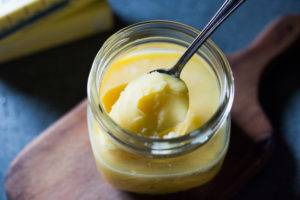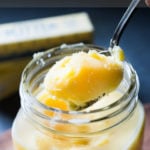Description
How to make ghee, plus 10 health benefits. A simple process that turns butter into the most flavorful foundation for authentic Indian cooking. Removing the milk solids out of butter makes it highly digestible, soothing to the body and according to Ayurvedic medicine, helps balance out the 3 doshas with many health benefits.
Ingredients
Instructions
Heat the butter in a medium, heavy-bottomed pot over medium-low or low heat.
Check every 10 minutes, skimming the foam that rises to the surface with a spoon or slotted spoon. The more butter you are cooking the longer this process will take.
When the milk solids drop to the bottom of the pan, you technically have “clarified butter”.
To make ghee, you’ll continue cooking until the solids turn deep golden brown like the color of brown sugar, and the butter will begin smelling nutty and earthy and get golden itself. During these last minutes, you don’t want to walk away from the stove, it goes very quickly from deeply golden to burnt!
Turn the heat off and let cool 3 minutes.
Strain, using 2 layers of cheesecloth over a strainer into a clean jar or pourable pitcher.
Pour into a clean, sealable, sanitized jar, and store on the counter, or refrigerate if you prefer.
Ghee will solidify slightly, especially in the colder months.
Notes
Nutrition
- Serving Size: 1 tablespoon
- Calories: 102
- Sugar: 0 g
- Sodium: 1.6 mg
- Fat: 11.5 g
- Saturated Fat: 7.2 g
- Trans Fat:
- Carbohydrates: 0 g
- Fiber: 0 g
- Protein: 0.1 g
- Cholesterol: 30.5 mg

